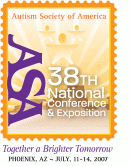 |
The ASA's 38th National Conference on Autism Spectrum Disorders (July 11-14, 2007) of ASAThe Westin Kierland Resort & Spa, Scottsdale, AZ |
| For a complete author index with session numbers, please click here | |
| Friday, July 13, 2007: 3:00 PM-4:15 PM | |||
| Mapmakers A & B | |||
| #2746- Getting the Message: Strategies and Activities for Teaching Facial Expressions* | |||
| Individuals with Autism Spectrum Disorder often have difficulty reading and understanding facial expressions, yet information and resources to help teach these skills are few. This session will look at how to informally access students’ abilities to read facial expressions and how to teach these skills using a systematic, step-by-step approach. Specific strategies will be discussed along with examples of a variety of instructional activities, which can be adapted to meet the individual needs of different learners.
| |||
| Presenter: | - Pat Crissey has worked for over 20 years as a special education teacher, autism consultant and author of educational materials, including Communication Skills for Children with Autism (Attainment Company, 2009). She has presented at numerous local workshops and national conferences, including the 2006 and 2007 ASA National Conferences. | ||
|
| |||
|
At the conclusion of this session, participants will be able to: 1. State the importance of teaching individuals to read facial expressions 2. State how they might informally assess an individual's ability to read facial expressions 3. Outline a sequence of skills that could be used to teach facial expressions. 4. State several effective learning strategies that are important when teaching individuals with autism to read facial expressions. 5. Provide several examples of activities that could be used to teach facial expressions. Individuals with Autism Spectrum Disorder often have difficulty reading, understanding and using facial expressions. Although this deficit has been well established, as well as the need for direct instruction in this area, an organized approach to teaching facial expressions has been lacking. Because of this need, the presenter has written a curriculum, Getting the Message: Learning to Read Facial Expressions, which is being published by Attainment Company, to be released in January 2007. In this workshop session, the presenter will share some of her insights into teaching facial expressions, along with various strategies and activities used in the curriculum. The session will first briefly consider the need for teaching facial expressions and the complexity of the task. We communicate more through facial expressions and body language than through our words. Those individuals who have difficulty reading these nonverbal signals, are simply not getting the messages that are being conveyed to them. Yet, instruction in this area is often lacking and it is little wonder when one considers the complexity of the task. Paul Ekman, one of the leading researchers in the field, identified over 10,000 different facial expressions. Yet, many facial expressions can appear the same. For example, is the person looking shy, embarrassed or ashamed? While teaching facial expressions can present many challenges, such instruction is essential for our students with Autism Spectrum Disorder, and the remainder of the session will provide helpful information on how to tackle this difficult task. The session will provide information on how to assess a student's need for instruction, through informal as well as formal assessment. Reference will be made to formal evaluations that can be used and ideas will be provided on how to informally assess students. Next the session will focus on breaking down instruction into a systematic, step-by-step approach. What should be taught first? How can you build progressively on a student's understanding and skill level? The presenter will present the sequence for teaching that she developed and uses in her curriculum. This approach begins with the basic emotions of happy, sad, angry, scared and neutral. First students learn to match similar facial expressions that display these basic emotions. Next they learn to identify the expressions by name. Students then learn to recognize and understand the basic emotions behind these facial expressions. Once students recognize and understand basic emotions and their corresponding facial expressions, attention is turned to recognizing intensity of basic emotions and learning the vocabulary used to describe the different intensities, such as, “annoyed” or “furious.” Next attention is turned to a variety of other, subtler emotions and their corresponding facial expressions. Some of the most important expressions for individuals with ASD to recognize are expressions that show when someone is interested or not interested and when someone is smiling, but is not sincere, such as expressions which actually convey mockery, sadness or confusion. Other facial expressions covered in the curriculum include disgust, embarrassment, confidence, shyness, shame, jealousy, confusion, doubt, surprise, concern and feeling sorry. Participants will next consider how to teach facial expressions incorporating those strategies known to be effective with students with ASD. These strategies include using activity-based instruction and visuals, helping students focus on what's important, pacing instruction and working towards generalization. Finally, ideas for different instructional activities will be presented and discussed. This will include what types of teaching materials are needed, such as mirrors, cameras, video and many drawings and photos. Suggested activities include direct instruction as well as practicing with mirrors, role-plays, various games, stop action video, read and pause stories, writing and art activities. Examples will be shown of how skills can be reinforced using Social Stories and work systems. Many of these activities can fit nicely into other curriculum areas. Ideas will be presented to adapt these activities to meet the needs of different learners and a range of age groups.
|
|||
See more of General Submissions
See more of The ASA's 38th National Conference on Autism Spectrum Disorders (July 11-14, 2007)